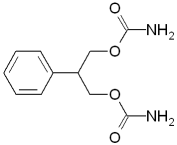Felbamate
Felbamate (marketed as Felbamol by MedPointe) is an anticonvulsant drug used in the treatment of epilepsy. It is used to treat partial seizures (with and without generalization) in adults and partial and generalized seizures associated with Lennox-Gastaut syndrome in children. However, an increased risk of potentially fatal aplastic anemia and/or liver failure limit the drugs usage to severe refractory epilepsy. more...
Mechanism of Action
As with most anticonvulsants, the precise mechanism is unknown. It has a weak inhibitory effect on GABA receptor binding sites.
Approval History
U.S.
- August 1993. Felbamate was approved for partial seizures with and without secondary generalization in adults and for Lennox-Gastaut Syndrome, a serious form of childhood epilepsy. Over the following year 150,000 people were started on felbamate therapy and a third of these became established.
- August 1st 1994. It was urgently withdrawn after 10 cases of aplastic anemia. A "Dear Doctor" letter was sent to 240,000 physicians.
- September 27th 1994. Felbamate had a limited redemption in another "Dear Doctor" letter sent to 260,000 physicians. It was recommended that the drug remain available only for patients with severe epilepsy for whom the benefits outweigh the risks, and that changes be made to the product's labelling to reflect the newly recognized risk . This redemption came with an additional warning since there had been 10 cases acute liver failure (4 of which were fatal). At this point, 10,000 to 12,000 people remained on the drug.
U.K.
- The drug is only available on a limited named-patient basis.
Indications & Usage
- Adults: Monotherapy or adjunctive therapy in the treatment of partial seizures, with and without generalization.
- Children: Adjunctive therapy in the treatment of partial and generalized seizures associated with Lennox-Gastaut syndrome.
Dosing
Felbamate is available in tablets (400 mg and 600 mg) and as a peach-coloured oral suspension (600 mg/5 mL).
- Adults (> 14 years): begin with 1,200 mg daily given every 6 to 8 hours
- Children (2 > 14 years): 15 to 45 mg per kg per day given every 6 to 8 hours
Side Effects
Adverse reactions include decreased appetite, vomiting, insomnia, nausea, dizziness, somnolence, and headache. Many patients report increased alertness with the drug. Two rare but very serious effects include aplastic anemia and hepatic (liver) failure. The risk of aplastic anemia is between 1:3,600 and 1:5,000, of which 30% of cases are fatal. The risk of hepatic failure is between 1:24,000 to 1:34,000.
Drug Interactions
Felbamate interacts with other AEDs, the dose of which may be reduced in order to avoid adverse effects.
Read more at Wikipedia.org



